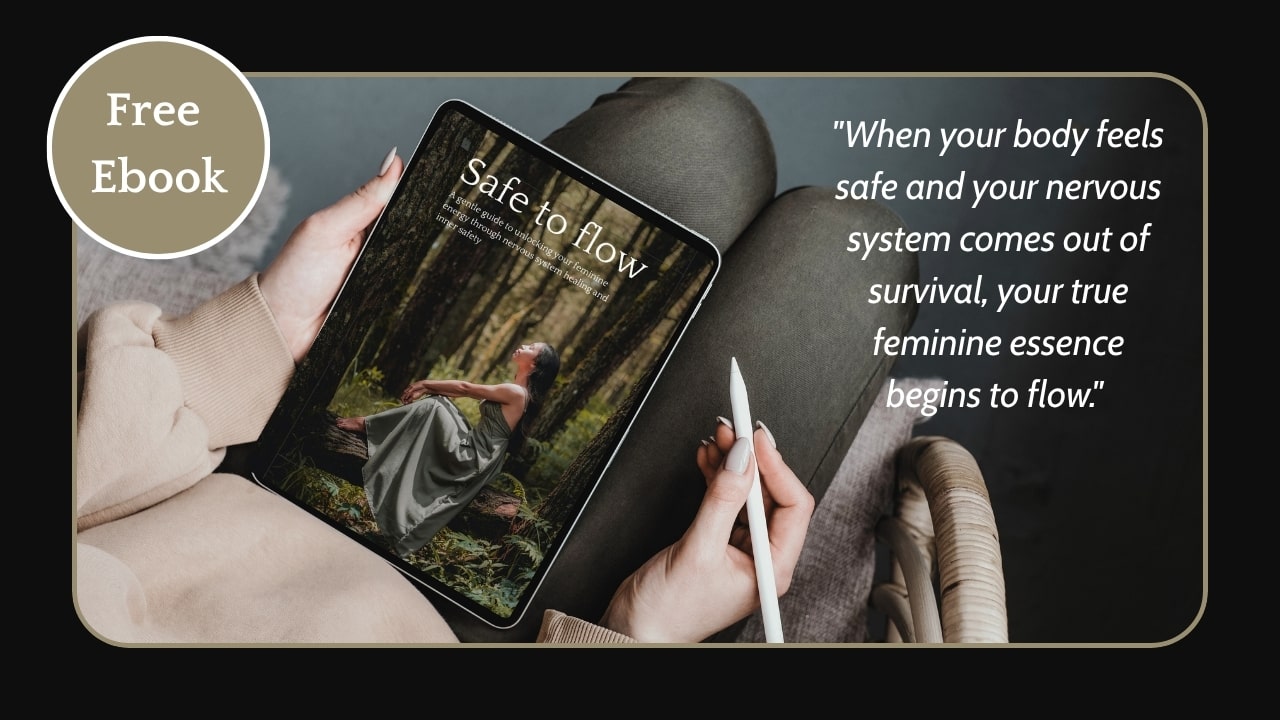How to stay in ventral vagal state and why it influences your leadership?

Have you ever met a woman, teacher, businesswoman, therapist, speaker, friend of a friend, and something about her made you feel safe and welcome? In this article, we will discover how, when a person evolves and communicates from a ventral vagal state, we feel safer around them. The ventral vagal state is a state of the nervous system theorised by polyvagal theory, also known as the science of safety. It affects various facets of our quality of life, as well as how we interact with others and the leadership we exhibit when sharing our knowledge or expertise with the world. Understanding the ventral vagal state and learning how to lean into it is an incredible gift to the world, as the safer we feel, the safer the people around us feel as well.
What is the ventral vagal state?
According to polyvagal theory, our nervous system constantly scans the world around us, asking a simple question: Am I safe, or am I in danger? The answer to that question determines how we feel, how we connect with others, and how we show up in life. When there is no sense of threat, we are in the ventral vagal state, also called the social engagement system. Here, our body feels calm, regulated, and open. We can breathe deeply, think clearly, and connect with others in a warm, present way. The world feels safe, and we feel safe inside ourselves. This is the state where curiosity, creativity, and compassion flow naturally—and it’s also the foundation of authentic leadership.
When our nervous system detects stress or danger, it shifts into the sympathetic activated state, also known as fight or flight. In this state, our body mobilises energy to protect us. You might notice your heart beating faster, your breath becoming shallow, or your muscles tensing. The world feels more threatening, and we may feel the urge to argue, run away, or push through with urgency. If the threat feels completely overwhelming and unmanageable, the nervous system takes us into the dorsal state, also called freeze or collapse. This is the body’s way of shutting down to protect us when fighting or fleeing isn’t possible. In this state, we may feel numb, exhausted, disconnected, or as if life is happening behind a foggy glass. The world feels distant, and we can feel stuck or powerless. If you want to learn more about the different states of the nervous system, check out this article: What is the polyvagal theory in a nutshell?
All of these states—ventral vagal, sympathetic activation, and dorsal shutdown—are automatic and unconscious responses. They are part of our biology, designed to keep us safe. None of them are “wrong” or “bad”—they are protective strategies. The gift is in recognizing which state we are in, so we can gently guide ourselves back toward the ventral vagal state, where connection, safety and relationships blossom. In other words, connecting with others from the ventral vagal state creates the foundation for thriving relationships, trust, and helps others feel valued and appreciated.
The impact of ventral vagal on leadership and communication
The state of our nervous system does not just shape how we feel inside. It also shapes how we show up in the world. It influences our thoughts, behaviours, body language, voice, and even the look in our eyes. And while this is happening within us, the same thing is happening in the people around us. Our nervous systems are constantly and unconsciously scanning for signals of safety or threat. This means that the state you are in will directly influence how others experience you. If you are speaking to a group, leading a workshop, or even having a one-on-one conversation, your nervous system is communicating just as much as your words.
When we are stressed and overwhelmed, our body reflects it. Our voice loses its richness and variety, becoming flat or tense. Our facial expressions seem less alive, our eyes may look distant, and our presence can feel cold or disconnected. Without us even realising it, others sense this. Their own nervous system picks up on those cues, and they may start to feel uneasy, distracted, or disconnected as well.
On the other hand, when we are anchored in the ventral vagal state, everything changes. Our voice becomes vibrant and dynamic, with natural shifts in tone that make it engaging and easy to follow. Our face looks more open and expressive, our smile feels genuine, and our eyes soften with warmth and a sense of presence. This creates a welcoming energy, one that invites connection and trust. A key quality of the ventral vagal state is playfulness. When we feel safe, we become naturally more curious, lighthearted, and open to joy. This quality is magnetic; it draws others in and makes them feel secure enough, too.
As leaders, teachers, or speakers, the more we can root ourselves in this state of safety, the more safety we extend to those around us. From this place, our message is clearer, our impact is stronger, and our presence is more soothing and inspiring. In fact, being in the ventral vagal state not only allows us to share our gifts with precision and joy, it also invites others into that same state of safety and connection. Just by being with us, people can feel regulated. Anchoring ourselves in the ventral vagal state is therefore not just about personal well-being. It is about leadership, influence, and connection.
How to stay in ventral state?
To anchor more safety in your leadership, the first key is self-compassion. It is essential to understand that shifting between states—such as ventral vagal, fight-or-flight, and freeze—is a natural, biological process. These shifts occur below the level of conscious choice, much like when you sneeze or your heart suddenly beats faster. You cannot simply decide which state you are in. Your nervous system follows a built-in hierarchy of responses: first the ventral vagal state (social engagement), then sympathetic activation (fight/flight), and finally the dorsal state (freeze/collapse). This sequence moves from the most recent to the most ancient survival response in our evolution. In other words, it is simply your biology at work, protecting and regulating your body. Because of this, the goal is never to judge yourself for leaving the ventral vagal state. Instead, the invitation is to approach nervous system regulation with curiosity and compassion. In fact, curiosity and compassion are themselves direct anchors into the ventral vagal state.
For example, imagine you are leading a workshop. Your body may naturally feel stress and tension. If you notice yourself shifting into fight/flight or even dorsal shutdown, don’t be hard on yourself. Instead, be curious: What made my body feel unsafe? What signal triggered this response? Treat it like an observation rather than a failure. This attitude of self-acceptance not only helps you regulate—it also radiates outward. When you treat yourself with compassion, curiosity, and kindness, others can sense this attitude. It invites them to practice self-compassion as well.
A gentle practice to return to safety
There are many ways to strengthen your ability to stay in the ventral vagal state, but one gentle practice you can start with is Notice, Name, Nurture.
Notice, Name, Nurture:
- Notice – Get curious about the sensations in your body. Where is the stress or tension? How does it feel? Does it have a colour, a shape, a texture? Observe, without judgment.
- Name – Put words to your experience. You might say: “This is what stress feels like in my body.” Or if you feel comfortable using nervous system language: “This is what an activated fight/flight state feels like.” By naming it, you bring what is implicit into awareness.
- Nurture – Soften into the moment. Let your breath soothe you, in and out, as if you were calming a child. You can even add gentle words, silently or aloud, such as “It’s okay,” or “It’s natural to feel stress, and I am safe.”
This simple practice helps bring you back into the ventral vagal state, where safety, connection, and playfulness live. Above all, remember: be gentle with yourself. Every shift of your nervous system is part of being human. And every act of curiosity and compassion you extend to yourself strengthens your capacity to lead with clarity, joy, and presence. I created a free eBook, "Safe to Flow", that offers simple, gentle nervous system practices designed to help you anchor your body in safety. To download it, click on the picture below:
Conclusion: leading from safety and connection
Leadership is not about consistently staying in the ventral vagal state. It is about learning to recognise where you are, approaching yourself with compassion, and gently returning to safety when you can. What matters is your own journey towards safety and the pleasure you can get from feeling safe enough to empower both yourself and others. The more often you anchor yourself in safety, even in small moments, the more you create a ripple effect in the spaces you lead.
This is the quiet power of ventral vagal leadership: it is not about performance or control, but about connection. By leading from safety, you invite others to feel safe. By showing compassion to yourself, you create an environment where others can do the same. And by sharing your gifts from a grounded state, your message becomes clearer, your impact deeper, and your relationships more authentic. Ultimately, leadership rooted in the ventral vagal state is not just about guiding others; it is about co-creating spaces of safety, connection, and joy where everyone can flourish. So let me leave you with a question: What would shift in your leadership—and in your relationships—if you could anchor yourself in safety more often?
You might also like:
What Is the witch wound? A nervous system perspective on appeasement and ancestral trauma
What is the neurobiology of feeling safe, and why is it important for feminine embodiment?


